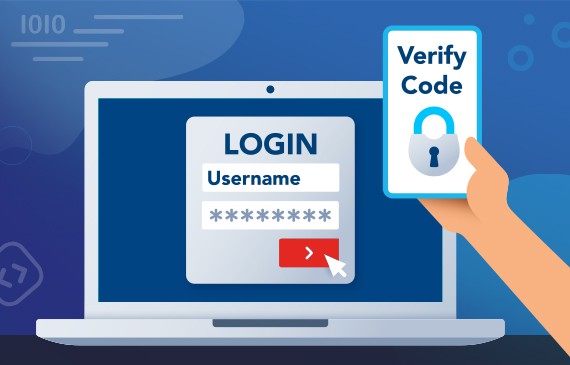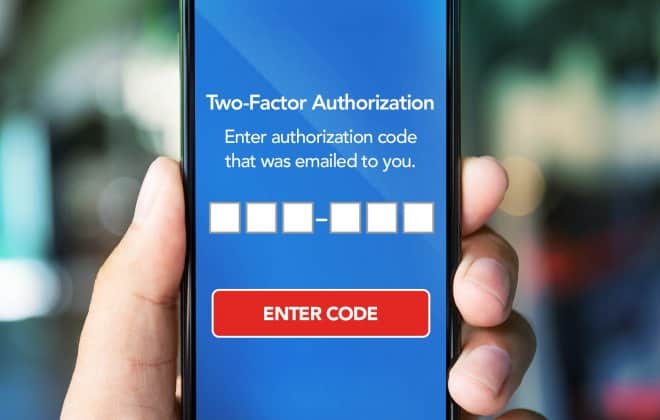Many people believe that using a password is enough to protect their information. But most people rarely change important passwords or don’t make them nearly sophisticated enough. All cybercriminals need are a reasonable brute force attack or social engineering trick to steal your password.
Multi-Factor Authentication (MFA), adds another layer of defense on top of your password. This second factor makes it so that only you can access a device you’re trying to use. And this second layer of security is much more difficult to break than a simple user password.
Of course, this second layer of security can take many forms. These forms can vary from a small piece of hardware or software on your phone that generates a unique number for you based on an algorithm and time, or an SMS message, email, push notification, etc… There are many forms of authenticating the user with Multi-Factor.
What MFA Options Does My Company Have?
Some MFA approaches are indeed more sophisticated than others. Biometrics, for example, like retina scans or fingerprinting, aren’t a viable option for most small- and mid-sized businesses.
Enter one-time passwords: a simple option that is widely scalable and viable for many companies. One-time passwords, or OTPs, use devices, like your smartphone or other physical component, to generate a password that’s unique to you.
So, what are some OTP options your business can start leveraging right away? Below are some of the most well-known approaches:
- SMS: SMS text messages are probably the most common, cost-effective OTP option out there. Once you log in with your first password, a second one gets sent to your phone that expires after a short period of time.
- Emailing: You can also opt to have OTPs sent to your email address. This is pretty similar to SMS — you get a short, unique code that you must use before it expires. Since pretty much all your employees likely use email and are comfortable using it, this approach is also cost-effective and straightforward to implement. However, not all MFA is created equal, and if a user has already been authenticated through email (such as sending a password reset email), then sending another factor of authentication to the same is NOT considered a true Multi-Factor.
- Token Systems: Token systems are hugely popular in more substantial enterprise outfits. These systems are accessible when you can’t rely on just SMS or email.
- There’re hardware token systems, which use physical devices to generate user codes. Hardware tokens are one of the most scale-able MFA approaches out there but are also one of the most expensive.
- Then there are software token systems, which use apps on a user device rather than relying on a physical device to generate an OTP. These are simpler to use as opposed to their physical counterparts but are more prone to exploitation if users aren’t knowledgeable enough.
How Can MFA Help with My Productivity?
Where and when employees get their work done these days isn’t so cut-and-dried. Many employees are remote and working on mobile devices or tablets. If your productive landscape is changing, it’s essential to give your employees liberty through MFA.
With MFA in place, you can rest assured that users have secure access to your organization’s data, no matter where they’re working from. If your employees need to use a SharePoint site or access an app, for example, they can stay productive without ever having to use your company’s network resources.

MFA is most immediately attractive because of how well it fortifies your security measures in place. But if you size it down to the level of individual employees, you’ll also start to see how it empowers their productivity. Employees who aren’t afraid or at risk of having their data compromised can keep getting quality work done anytime, anywhere.
After all, letting your employees get work done where and when they want is a safe bet to keep them happy for longer. Between enabling an agile workforce of mobile go-getters and giving your IT department some peace of mind, implementing MFA should be a no-brainer if you’re trying to maximize your company’s efficiency.
Sounds Great, So Far. But Will MFA Help My Company Save Money?
Implementing MFA might sound like a pie-in-the-sky endeavor if you can’t tell how it’ll affect your bottom line. And to be fair, it might not seem immediately obvious how MFA can affect your company’s cost savings.
So, the question still stands — will implement Multi-Factor authentication help my company save money?
Here’s the short answer: Absolutely, yes. Cyber thieves who can’t compromise your data can’t steal much of anything.
Now for the longer answer: Yes, especially if you have the right tools in place.
First, think about the time you can save implementing MFA. The less time it takes for your customers to access your services, the more of those services they’re likely to use. And the easier it is for them to use your services, the more likely it is they’ll recommend them to others.
Still not convinced? Just take a look at digital giants like Amazon or Google, who use MFA SMS services in bulk to keep attracting customers. Not only do these companies’ MFA services save their customers time, but they also assure them that they’re safe when using their platforms in the future.
Then there’s the load off your IT help desk. It’s estimated that more than 30% of submitted help desk tickets are just to get users’ passwords reset. That’s a lot of time spent working on avoidable security-related issues. The less time your IT analysts spend fixing data breaches, the more productive they’ll be on efforts that’ll directly affect your company’s bottom line.
And the best part? You only need to implement MFA services once. Multi-Factor authentication is a single investment that empowers your operations and IT teams by freeing them of constant security issues and letting them spend quality time on improving their services.
Implement MFA Today to Secure Your Company’s Assets Tomorrow
Your business is likely transforming as quickly as the rest of the digital world. This means that having standard password-protected assets is no longer enough to protect you from cyber thieves.
With Multi-Factor authentication implemented, there’s no need to worry about the future of your company’s security landscape. It’s a proven, effective way of strengthening your bottom line and delivering quality services more quickly.
Empower your employees and productivity with MFA and stop worrying whether your single passwords are enough to protect your business.


